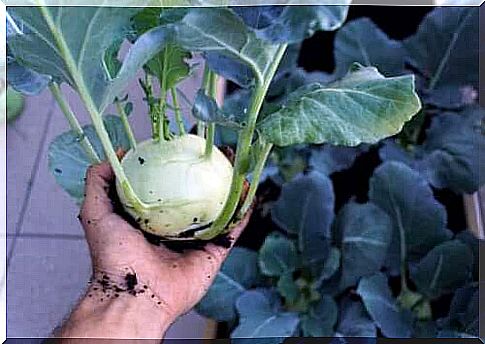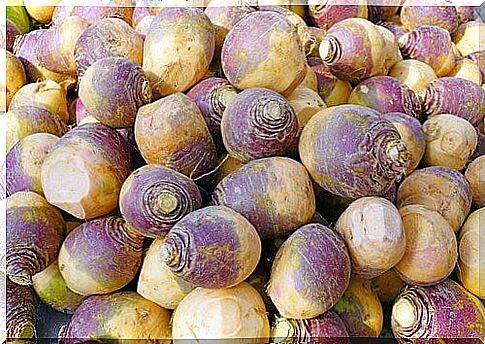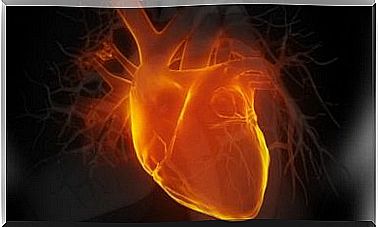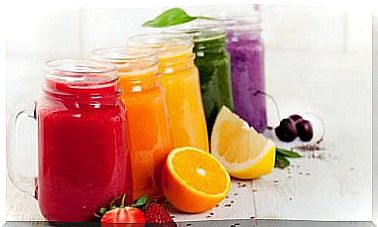Swede Cabbage: Nutritional Values, Benefits And Cooking

Cabbage or turnip? Although the difference seems remarkable, there is a vegetable in which both are blended: the swede cabbage.
It is a cross between cabbage ( Brassica oleracea ) and turnip ( Brassica rapa ). Considered a cruciferous tuber, it is also known by the name of rutabaga or Swedish turnip.
Author Percival describes it as a cabbage with a stem similar to that of a turnip. This root is thought to originate in the 17th century Czech Republic, and to be a cross between wild cabbage and turnip. It is grown in North America, Canada and Northern Europe, where it is part of the gastronomic tradition.
There are two types: common, with purple skin (which is confused with radish) and Lapland, a Canadian variety with a creamy pulp. Both the leaves and the bulb of the swede are cooked.
Both have a flavor and texture similar to that of broccoli and cabbage, but once cooked they acquire a sweetish flavor, similar to that of a sweet potato.
Nutritional values of swede cabbage
The swede has surprising quantities of the nutrients we are about to talk about, based on the data reported on the nutritional table of foods (expressed in grams, based on 100 grams of raw product).
For vitamins and minerals, the percentages of recommended daily allowances (RDAs) are shown:
- Calories: 27.
- Carbohydrates: 6.2 grams.
- Fiber: 3.6 grams.
- Vitamin B6: 0.15 milligrams – equal to 12% of the RDA.
- Protein: 1.7 grams.
- Vitamin C: 62 milligrams – 103% of the RDA.
- Potassium: 350 milligrams – equal to 7% of the RDA.
- Phosphorus: 46 milligrams – 4% of the RDA.
- Vitamin B9: 16 milligrams – equal to 4% of the RDA.
Some scientific studies
Swede cabbage provides vitamin C in excess of the recommended daily allowances.
According to a study by Castillo-Velarde, vitamin C can be considered a very powerful antioxidant against free radicals.
In addition to this, some doctors recommend it because of its healing properties and because it stimulates the absorption of iron and for its immunomodulatory capacity.
However, the heat can destroy it. Precisely for this reason some experts suggest cooking it in the microwave or steam. Turnip cabbage meets up to 12% of the recommended vitamin B6 requirement.
Brown and other authors recognized the importance of pyridoxine for protein metabolism for red blood cell production and for immune health.
This interesting root is also a valuable source of potassium, a mineral that, according to pharmacology expert Tejada Cifuentes, preserves heart health and, as an electrolyte, also fluid balance.
On the other hand, a cup of swede cabbage (equal to 135 grams) provides about 17% of the daily requirement of fiber. In addition, it is recommended by nutritionists because it helps prevent diabetes, maintain a healthy weight, and protect gastrointestinal health.

Possible health benefits of turnip cabbage
Swede are recognized multiple properties for health, thanks to its content of specific nutrients and bioactive components.
We see some of them and their respective scientific studies supporting their properties.
Source of antioxidants
The antioxidant properties of swede cabbage are highlighted in the magazine Preventive Nutrition and Food Science .
In addition to vitamin C, in fact, it also contains phytochemicals that block the action of free radicals. Anthocyanins, isothiocyanates, sulforaphanes and glucosinolates are some of these.
The purple skin of the swede is particularly rich in anthocyanins, pigments that give a red, purple or blue color to some fruits and vegetables.
Cassidy and others argue that these pigments help prevent heart disease, while Devore and other authors associate their presence with reduced mental deterioration.
Swede cabbage – especially the purple one – contains isothiocyanates and glucosinolates. According to some observational studies, these components are associated with a lower incidence of colorectal cancer, although more studies are needed to confirm this.
It can prevent heart disease
Some researchers argue that cruciferous glucosinolates are vasodilators and reduce inflammation ; for this reason they are associated with a lower risk of heart disease.
On the other hand, isothiocinates prevent the accumulation of fatty plaques in the arteries.
Anthocyanins can also lower blood pressure and reduce the risk of heart abnormalities, according to a group of experts and published in the journal Circulation .
It is not only the presence of phytochemicals that potentially reduces the risk of developing cardiovascular diseases. The high fiber content protects against heart dysfunction, according to a review of 15 studies that reduced the chances of suffering from similar conditions by 24%.
Protects intestinal health
Swede is a high-fiber crucifer. One cup a day satisfies 17% of the recommended fiber requirement.
Nutrients magazine has shown that some types of soluble fiber can act as prebiotics, which is a food rich in good bacteria such as bifidobacteria and lactobacilli. A review on the topic speculates that fiber protects gut health and prevents obesity and heart disease.
Prebiotic fibers are also mentioned in other trade journals for positive effects on bacteria associated with immune health.
It’s not all. Digestive system experts recommend consuming insoluble fiber to increase stool volume and help improve constipation.
It can strengthen the immune system
Swede can offer some vitamin B6 to the diet. A cup a day of this food covers up to 15% of the recommended dose.
Vitamin B6 contributes to the production of T cells and white blood cells. These immune cells that cope with external agents and important for the health of the immune system.
Several scholars agree that supplements of vitamin B6 and other micronutrients improve the three levels of the defense mechanism.
On the other hand, Nutrients magazine highlights the role of ascorbic acid in strengthening the functions of white blood cells and the immune system. The vitamin C contained in the swede cabbage totally satisfies the daily requirement of an adult.
Precautions in the consumption of swede cabbage
Some dermatological studies have highlighted forms of food hypersensitivity to swede. Itching, atopic dermatitis, rash, rhinitis, respiratory problems, gastrointestinal disturbances and allergic contact reactions may occur.
On the other hand, a scientific review points to the importance of consuming swede in moderation, and also to be cautious with the anticoagulant warfarin, as they can interfere with each other.

How to cook swede cabbage?
Swede can be prepared raw or cooked. When eaten raw, its flavor is reminiscent of broccoli, but it is more delicate and has a spicy touch.
We can add it to salads, grate it or cut it into thin slices or julienne. We can serve it with a side dish, instead of sweet potatoes or as part of a plate of mixed vegetables.
If you prefer, know that it is particularly suitable to be served as a raw pinzimonio, with hummus. Since the peel is quite difficult to chew, you can easily remove it with a sharp knife.
You can prepare the leaves raw or in salads, or steam them like chard or spinach. Alternatively, sauté them in a pan to add them to a soup.
When we cook the tuber, it will become sweeter. If you prefer cooking in the oven, the advice is to let it brown, until it is softened; or, combine it with cauliflower, broccoli and add onions to create a contrast with the flavor of crucifers.
How delicious it is velvety! We can mix it with chicken broth, boiled potatoes, herbs and vegetables. Remember that the lower the heat during preparation, the better you will absorb the vitamin C from the swede. So, you can steam it or sauté with garlic, olive oil and a pinch of chopped parsley.
Swede is a type of vegetable rich in nutrients and active compounds that are beneficial to health. In addition, it is very rich in vitamin C, B6, fiber and flavonoids. We can consume it raw or cooked, alone or with other vegetables, not without first making sure you are not allergic to its components.









